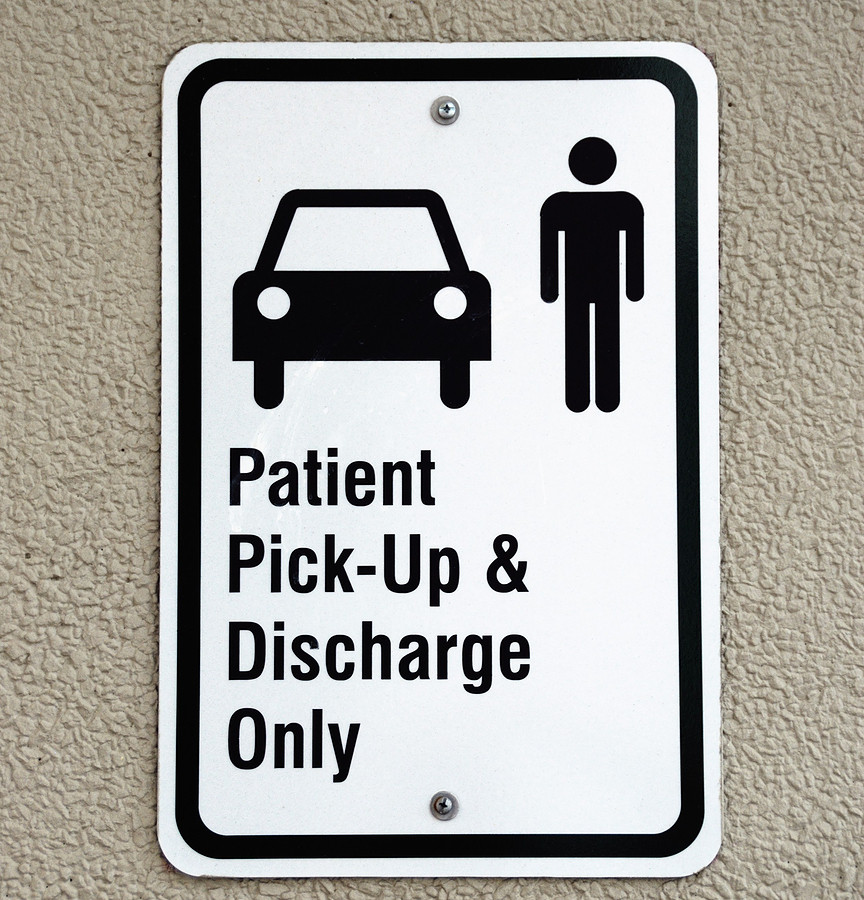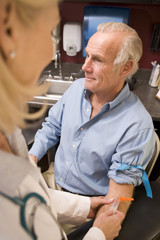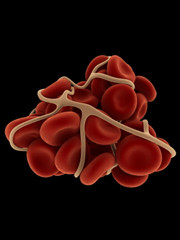
5 timeless habits for better health

What are the symptoms of prostate cancer?

Is your breakfast cereal healthy?

When pain signals an emergency: Symptoms you should never ignore

Does exercise give you energy?

Acupuncture for pain relief: How it works and what to expect

How to avoid jet lag: Tips for staying alert when you travel

Biofeedback therapy: How it works and how it can help relieve pain

Best vitamins and minerals for energy

Should you take probiotics with antibiotics?
Harvard Health Blog
Read posts from experts at Harvard Health Publishing covering a variety of health topics and perspectives on medical news.
Articles
Medication errors a big problem after hospital discharge
After a hospitalization, being discharged is a key step on the road to recovery. But that road can take a dangerous turn—namely, a serious problem with one or more medications. It’s a common problem that many people experience within a few weeks of leaving the hospital. Researchers at Brigham and Women’s Hospital reported in the […]
Harvard expert urges caution for use of new prostate cancer test
The FDA has approved a new kind of PSA test for prostate cancer that its maker claims can help doctors do a better job of telling the difference between prostate cancer and less worrisome conditions such as prostate infection or benign prostate enlargement. The test, called the Prostate Health Index (PHI), should become available in the U.S. later this summer. The PHI combines measurements of three kinds of prostate specific antigen (PSA), a protein produced by the prostate gland. In theory, the combination could help reduce the number of men who undergo prostate biopsies when their PSA levels are slightly above normal, in the 4 to 10 nanogram per milliliter range. But doctors must take care not to allow use of the PHI test to worsen the existing overdiagnosis and overtreatment of low-risk cancers, according to Dr. Marc B. Garnick, an expert in prostate cancer at Harvard Medical School and editor in chief of HarvardProstateKnowledge.org.
Backyard gardening: grow your own food, improve your health
A new book from First Lady Michelle Obama, “American Grown: The Story of the White House Kitchen Garden and Gardens Across America,” details the challenges and joys the First Lady has experienced with her now-famous White House garden. It also looks at community gardens all across America, and how they can improve health. The book contains helpful hints for starting your own vegetable garden, as well as a school or community garden. This effort dovetails with Mrs. Obama’s “Let’s Move” initiative. In addition to getting more physical activity, so the thinking goes, eating more food harvested from the ground and less from packages can help kids — and adults — become healthy or stay that way. The health benefits of growing your own food range from helping you eat more fresh fruits and vegetables to deciding what kinds of fertilizers and pesticides come in contact with your food.
Heart attack can trigger PTSD
We usually think of post-traumatic stress disorder (PTSD) as an aftermath of military combat or terrible trauma. It can also strike heart attack survivors. By the latest account, 1 in 8 people who live through a heart attack experiences a PTSD-like reaction that might be called post-traumatic stress disorder (PTSD). They experience the same key symptoms: flashbacks that occur as nightmares or intrusive thoughts. They try to avoid being reminded of the event and become hypervigilant worrying that it will happen again. As treatments for heart attack continue to improve, 1.4 million people a year are now surviving the event long enough to be discharged home. If the study is correct, 168,000 of them will be diagnosed with PTSD every year. It’s a grim reminder that as we get better at fixing the body, we must recognize the need to treat the mind.
Studies question ban on alcohol during pregnancy
Drinking alcohol during pregnancy has been taboo for some time, largely because drinking too much can cause fetal alcohol syndrome (FAS). Because no one has been able to identify a clear threshold for “safe” drinking during pregnancy, doctors tell women to steer away from alcohol entirely. A series of five studies from Denmark published in BJOG An International Journal of Obstetrics and Gynaecology found that “low” (1-4 drinks per week) to “moderate” (5-8 drinks per week) alcohol consumption in early pregnancy did not harm the neuropsychological development of children evaluated at age five. Drinking more appears to be a different story. In one of the studies, five-year-olds whose mothers consumed higher levels of alcohol (9 or more drinks per week) during pregnancy were significantly more likely to have lower attention spans. The authors of the study do not argue that drinking alcohol during pregnancy is wise or to be encouraged. In fact, most doctors will continue to advise pregnant women not to drink alcohol. is there a middle ground? Perhaps. Deciding to have a sip (or glass) of champagne at a special occasion during pregnancy may not be an unreasonable or unsafe choice–one that each woman has to make for herself, ideally after talking with her obstetrician or midwife about this issue.
Gene may explain why some smokers must fight to quit
Why is it so incredibly hard to quit smoking—even when you are desperate to do so? For some people, the answer may be in their genes. In a report published online in the American Journal of Psychiatry, a team led by Dr Li-Shiun Chen of the Washington University School of Medicine identified a “high risk” version of a nicotine receptor gene that is more common in heavy smokers. Those with the high-risk gene took two years longer to quit smoking. But there was a silver lining: smokers with the high-risk gene were three times more likely to respond to smoking cessation therapies. The study provides hope for even hardcore smokers. However long it takes, quitting is beneficial. In a study published in the Archives of Internal Medicine, quitting smoking reduced the risk of dying—even in people in their 80s. “Even older people who smoked for a lifetime without negative health consequences should be encouraged and supported to quit,” the researchers wrote.
Alcohol abuse linked to weight-loss surgery
For people who are obese, the operation known as gastric bypass surgery has been hailed as something of a miracle. In addition to rapid weight loss, it can reverse diabetes and reduce the risk of heart disease. A new study reveals potential darker side—an increase in alcohol abuse. In a presentation at yesterday’s annual meeting of the American Society for Metabolic and Bariatric Surgery, researchers reported that almost 11% of nearly 2,000 men and women who underwent gastric bypass surgery (the most common type of obesity surgery) got in trouble with drinking by the second year after surgery. About 7% drank too much before the operation, representing a 50% increase. This finding shouldn’t steer people who could benefit from gastric bypass surgery away from the procedure. But it should prompt them—and their doctors—to be on the lookout for changes in alcohol use or abuse afterward.
5 tips for celebrating Men’s Health Week
The run-up to Father’s Day should be about more than ties, golf balls, and deciding what to grill on Sunday. Health should also be on the agenda. Men’s Health Week was created by the U.S. Congress in 1994 to boost awareness of men’s health and ways to improve it. It’s a good time for men to contemplate their vigor, fitness, and overall health—and then do something about it. Here are five things you can you do to improve your health. 1) Get moving. 2) Get checked for colorectal cancer. 3) Know your blood pressure. 4) Cut back on sodium in your diet. 5) Don’t ignore warning signs. This week, give yourself the gift of good health. And keep it going beyond Father’s Day.
Silent Spring at 50: Connecting human, environmental health
Fifty years ago this week, the first installment of Silent Spring appeared in the pages of The New Yorker. The book, published a few months later, was a sustained, meticulously reported account of the toll that widespread aerial spraying of DDT, dieldrin, aldrin, chlordane, heptachlor, and other synthetic pesticides was taking on birds, raccoons, fish, bees, and even the supposed beneficiaries of spraying—humans. Silent Spring is often portrayed as a book about saving birds and other wildlife. Another important theme is the essential but fragile connections between environmental health and human health. Silent Spring was instrumental in banning the use of many dangerous pesticides. It helped spark the modern environmental movement, launch the Environmental Protection Agency, and pass the Clean Water Act and the Endangered Species Acts. It is in the Modern Library’s 100 best nonfiction books, and Discover magazine named it one of the 25 greatest science books of all time.
Some antibiotic, antifungal drugs don’t mix with warfarin
Millions of people depend on the blood thinner warfarin to prevent clots from forming in their blood. It’s an important drug, but tricky to use. One problem with warfarin (Coumadin, Jantoven, generic) is that it interacts in potentially harmful ways with other medications. Two problematic types are antibiotics and antifungal agents. As we write in the June issue of the Harvard Heart Letter, this isn’t just a problem with pills, but can also happen with ointments, creams, and suppositories. Adding an antibiotic such as cotrimoxazole, cephalexin, or penicillin, or an antifungal medicine such as itraconazole or ketoconazole on top of warfarin can heighten warfarin’s blood-thinning ability. This raises the risk of internal bleeding or sustained bleeding after an injury.
Natural “exercise” hormone transforms fat cells
Exercise makes cells burn extra energy—that’s one way it helps control weight. It also generates a newly discovered hormone, called irisin, that transforms energy-storing white fat cells into energy-burning brown fat cells. Irisin also appears to help prevent or overcome cellular changes that lead to type 2 diabetes. The hormone does this by helping transform energy-storing white fat cells into energy-burning brown fat cells. White adipose tissue, more commonly known as body fat, is the tissue that dimples thighs, enlarges waists and derrieres, and pads internal organs. Each white fat cell stores a large droplet of fat. Brown fat, in comparison, is chock full of energy-burning mitochondria. Its main function is to generate body heat by burning fat. A team led by Dr. Bruce Spiegelman, professor of cell biology and medicine at Harvard Medical School, has identified irisin in mice and humans and showed how irisin transforms white fat cells into brown ones, at least in mice.
Silent strokes can jeopardize memory
The symptoms of a stroke are sometimes obvious, like numbness or weakness on one side of the face, trouble speaking, difficulty walking, and vision problems. Some strokes, though, pass completely unnoticed—at least right away. But as reported in the June issue of the Harvard Women’s Health Watch, the damage these so-called silent strokes cause to fragile brain tissue can have significant and lasting effects on memory. Although silent strokes don’t cause any obvious symptoms, the interruption in blood flow to the brain can harm the processes needed to form or recall memories, especially if several of them occur over time. You can help prevent silent strokes the same way you others, by controlling blood pressure and cholesterol, not smoking, eating a healthy diet, and exercising.
NSAIDs—pain relief and skin cancer protection in one pill?
Aspirin, ibuprofen, and naproxen can subdue a pounding headache and ease arthritic aches. Could these and other nonsteroidal anti-inflammatory drugs (NSAID) serve double duty, protecting against skin cancer even while they relieve pain? A new study published online in the journal Cancer suggests they might. But based on the current evidence, cancer prevention alone doesn’t […]
Eating for pleasure easier to overdo than eating when hungry
When you polish off a piece of chocolate cake and immediately start thinking about having another, you might suspect that eating for pleasure may trigger overeating. A new study out of Italy, where they know a thing or two about good food, supports this notion. Researchers from Naples and Salerno found that eating for enjoyment […]
Link between calcium supplements and heart disease raises the question: Take them or toss them?
Calcium supplements are being called on the carpet after new research showed they significantly increased risk of heart attack among women getting extra calcium from pills, but not among those who got their calcium from food. What’s the connection? Over time, calcium can accumulate in arteries. It also builds up in plaque, the cholesterol-filled pockets that can cause angina or a heart attack. Three Harvard professors say the new study doesn’t prove that calcium supplements cause heart disease, but advocate that it’s almost always best to get vitamins and minerals from food, not pills.
Breast cancer in men: uncommon, but catching it early is vital
Breast cancer isn’t just a woman’s disease. Men can get it, too—about 1% of breast cancer is diagnosed in men. Since few men know that, they often fail to recognize its earliest signs and end up seeing a doctor later in the process than women do. The result: Men face treatment for larger and more advanced tumors, and their cancer is more likely to have spread to other parts of the body. The largest study to date on outcomes in men with breast cancer indicates that the five-year survival rate for women with breast cancer was 83%, compared to 74% for men. Even men diagnosed with early stage breast cancer still fared worse than women, although the gap closed for men and women diagnosed with later-stage disease. Since breast cancer in men isn’t often on doctors’ radar screens, men should be aware and check themselves.
Thigh fractures linked to osteoporosis drugs; long-term use questioned
Since bisphosphonates such as alendronate (Fosamax), ibandronate (Boniva), risedronate (Actonel), and zoledronic acid (Reclast) were first introduced in the mid-1990s, they’ve become a staple of osteoporosis treatment. Yet an FDA review recently published in The New England Journal of Medicine questions whether there’s any benefit to staying on these drugs long-term—especially considering their potential for side effects. A report released today in the Archives of Internal Medicine highlights one of those side effects, linking bisphosphonate use to a higher risk of unusual fractures in the femur (thighbone). If you’ve been taking bisphosphonates long-term, you may be wondering, “What now?” If you’ve been taking bisphosphonates for less than five years you probably don’t need to change what you’re doing. But if you’ve been on these drugs for more than five years, talk to your doctor about whether it’s worth continuing.
Wallets rejoice as Plavix goes generic
Millions of people with heart disease who take the blood thinner clopidogrel (Plavix) can now look forward to having fatter wallets. Plavix lost its patent protection this month, and on May 17 the Food and Drug Administration gave several companies the okay to sell its generic form. Clopidogrel users can now buy brand-name Plavix for a premium price, or equally effective generic clopidogrel in a 75-mg dose at a much lower cost. The change may also save lives. “We have seen more than a few patients have heart attacks because they had stopped taking clopidogrel due to the expense,” said Dr. Thomas Lee, professor of medicine at Harvard Medical School and Co-Editor in Chief of the Harvard Heart Letter. “I think the lower price is going to save some lives.” Before a company can sell a generic version of a drug, it must prove to the FDA that the drug is as effective and safe as the original.
Chicken Soup for the Soul and Harvard Health serve up inspiration, information
A new series of books is bringing readers the kind of inspirational stories that have made Chicken Soup for the Soul books international bestsellers plus with trusted health advice from Harvard Medical School. The combination of stories providing hope, inspiration, and great person-to-person advice plus straight talk and life-changing medical information from Harvard doctors will help readers live healthier, more satisfying lives. Each book focuses on a single topic. The first four will be available beginning May 22, 2012. They are Chicken Soup for the Soul: Boost Your Brain Power! by top neurologist Dr. Marie Pasinski; Chicken Soup for the Soul: Say Goodbye to Back Pain! by leading physical medicine expert Dr. Julie Silver; Chicken Soup for the Soul: Say Goodbye to Stress! by noted psychologist Dr. Jeff Brown; and Chicken Soup for the Soul: Say Hello to a Better Body! by respected internist Dr. Suzanne Koven.
Laxative-free colonoscopy on the way?
An experimental approach to virtual colonoscopy could eliminate the unpleasant day-before bowel prep that keeps many people from having this potentially life-saving test. Virtual colonoscopy uses computed tomography (CT) scanning with X-rays, instead of a scope, to check the colon for cancers and precancerous polyps. Earlier version have required bowel cleaning, just like regular colonoscopy. A Harvard-based team led by Dr. Michael Zalis uses sophisticated computer software to make stool in the colon disappear. It’s a little like Photoshopping blemishes from still photos. “Laxative-free CT colonography has the potential to reach some of the unscreened population and save lives,” says Dr. Zalis, an associate professor of radiology at MGH and director of CT colonography at MGH Imaging.

5 timeless habits for better health

What are the symptoms of prostate cancer?

Is your breakfast cereal healthy?

When pain signals an emergency: Symptoms you should never ignore

Does exercise give you energy?

Acupuncture for pain relief: How it works and what to expect

How to avoid jet lag: Tips for staying alert when you travel

Biofeedback therapy: How it works and how it can help relieve pain

Best vitamins and minerals for energy

Should you take probiotics with antibiotics?
Free Healthbeat Signup
Get the latest in health news delivered to your inbox!
Sign Up

























